The Top 8 Bitcoin Lightning Wallets Compared & Reviewed
The article discusses the development and adoption of the Bitcoin Lightning Network, which aims to address Bitcoin's scalability issues and enable fast, cheap transactions. The author highlights the limitations of Bitcoin's transaction processing speed, with only 7 transactions per second, compared to Ethereum's 13 transactions per second. However, they note that Layer2s or sidechains like Polygon have improved Ethereum's transaction speed, reaching theoretical outputs in the tens of thousands per second.
The article explains that the Lightning Network was introduced in 2015 as a solution for Bitcoin's scalability problem. It allows for off-chain micropayments through nodes and channels, making transactions faster and more cost-effective. The author emphasizes the importance of Lightning Network wallets in enabling users to make and receive Lightning payments. They categorize Lightning wallets into two types: custodial wallets, where funds are stored with a third party, and non-custodial wallets, where users have full control over their funds.
The article examines several Bitcoin Lightning wallets, discussing their key features and functionality. Wallet of Satoshi is described as the world's simplest Lightning wallet, with a clean and user-friendly interface. Electrum, a non-custodial wallet, is praised for its security features and compatibility with hardware wallets. Other wallets mentioned include Breez Mobile, Zap Wallet, Muun Wallet, Phoenix Wallet, Zeus Wallet, and Bitcoin Beach Wallet Blink.
The article concludes by noting the gradual increase in Bitcoin adoption for everyday transactions and the potential for viewing Bitcoin as a new currency denomination. The author suggests that mobile wallets are a convenient option for users, with the possibility of running their own Lightning node for those who are more advanced. They also highlight the importance of considering the balance between convenience and security when choosing a wallet.
Overall, the article provides a comprehensive overview of the development and adoption of the Bitcoin Lightning Network and highlights several Bitcoin Lightning wallets for users to consider.
The article discusses the development and adoption of the Bitcoin Lightning Network, which aims to address Bitcoin's scalability issues and enable fast, cheap transactions. The author highlights the limitations of Bitcoin's transaction processing speed, with only 7 transactions per second, compared to Ethereum's 13 transactions per second. However, they note that Layer2s or sidechains like Polygon have improved Ethereum's transaction speed, reaching theoretical outputs in the tens of thousands per second.
The article explains that the Lightning Network was introduced in 2015 as a solution for Bitcoin's scalability problem. It allows for off-chain micropayments through nodes and channels, making transactions faster and more cost-effective. The author emphasizes the importance of Lightning Network wallets in enabling users to make and receive Lightning payments. They categorize Lightning wallets into two types: custodial wallets, where funds are stored with a third party, and non-custodial wallets, where users have full control over their funds.
The article examines several Bitcoin Lightning wallets, discussing their key features and functionality. Wallet of Satoshi is described as the world's simplest Lightning wallet, with a clean and user-friendly interface. Electrum, a non-custodial wallet, is praised for its security features and compatibility with hardware wallets. Other wallets mentioned include Breez Mobile, Zap Wallet, Muun Wallet, Phoenix Wallet, Zeus Wallet, and Bitcoin Beach Wallet Blink.
The article concludes by noting the gradual increase in Bitcoin adoption for everyday transactions and the potential for viewing Bitcoin as a new currency denomination. The author suggests that mobile wallets are a convenient option for users, with the possibility of running their own Lightning node for those who are more advanced. They also highlight the importance of considering the balance between convenience and security when choosing a wallet.
Overall, the article provides a comprehensive overview of the development and adoption of the Bitcoin Lightning Network and highlights several Bitcoin Lightning wallets for users to consider.
Bitcoin’s birth came on the heels of the 2008 financial crisis, one of the most defining crises of the decade. The title of the Bitcoin white paper called it a “Peer-to-peer Electronic Cash system." Ironically, it is ill-equipped to fulfil the narrative of becoming a global payment network, at least, not until the Bitcoin Lightning Network becomes more widely adopted.
Despite the top-notch security and limited token supply that drives the value of Bitcoin, the network’s transaction processing speed leaves much to be desired, moving at a paltry 7 transactions per second.
Ethereum, its second closest competitor in terms of market cap, fared slightly better with 13 transactions per second. However, blockchains known as Layer-2s or sidechains like Polygon have taken on the burden of processing transactions on behalf of Ethereum. These alternative solutions greatly speeded up the processing speed, with theoretical outputs in the tens of thousands per second, rivalling Visa and Mastercard.
No such layer existed for Bitcoin until the Lightning network came about in 2015. Due to the fast processing speed and low transaction fees, the popularity of the project increased. One thing that brought the project to the forefront is the development of Lightning Network wallets. In this article, we are going to look at the top 8 Bitcoin Lightning Wallets.
Don't forget to check our top picks for hardware, desktop, and mobile wallets.
| Wallet | Key Features | Pros | Cons |
|---|---|---|---|
| Wallet of Satoshi | Simple UI, Buy BTC via Moonpay, BTC map integration, Biometric login | Very easy to use, Great for beginners, No setup needed, Spend BTC easily | Custodial wallet, Limited privacy, Region-restricted Moonpay purchases |
| Electrum | Multisig, Watch-only mode, Hardware wallet support, Lightning payments since 2020 | High security, Full control over settings, Supports advanced configurations | Steep learning curve, Not beginner-friendly, No iOS support |
| Breez Mobile | Runs mobile Lightning node, POS support, Podcast tipping, Google Drive backup | Great for merchants, Fun podcast feature, Full control via own node | Not private due to cloud backup, Still in beta, Requires balance to remain active |
| Zap Wallet | External node connection, Tor integration (planned), Buy BTC (planned), Desktop & mobile apps | Good for advanced users, Desktop support, Potential for high privacy | Requires separate node setup, Mobile version lacks full functionality |
| Muun Wallet | 2-of-2 Multisig, Emergency Kit, Submarine Swaps, Fee estimator | Strong security, Innovative swap features, Great UI for a non-custodial wallet | No in-app node, Some advanced features may confuse new users |
| Phoenix Wallet | Auto channel creation, Full mobile Lightning node, Channel fee control | True Lightning node on mobile, Easy channel management, Good UX | Requires 10,000 sats to activate, Channel creation fees can stack up |
| Zeus Wallet | Node management app, Tor support, Privacy mode, Open source | Ideal for node runners, Strong privacy, Full transparency via open source | Requires external node, Not for beginners, More of a companion tool than standalone wallet |
| Bitcoin Beach Wallet | Synthetic USD (Stablesats), Earn & Learn feature, Local merchant map, Nostr tips, POS support | Great for onboarding, USD stability option, Education-focused, Merchant tools included | Custodial, Phone number login may concern privacy users, Limited advanced wallet controls |
Summary
Key Features of These Wallets Are:
Nodes – A Lightning node is required to perform transactions on the Lightning network. It has two responsibilities: monitor the Bitcoin network to ensure the funds’ safety, and perform transactions by communicating with other nodes. It keeps tabs on which channel has how much so that there will be enough to make a payment when the need arises.
Channels – Channels are how two parties pay each other. Each party opens a channel on a node by depositing some BTC in it. Think of a channel like the sender and receiver. They need to know who is on the other end making and receiving the payment. How the payment is made is the node’s business. It can be a direct payment between two nodes, or it could involve multiple nodes along the way.
Both the opening and closing of channels are recorded on the Bitcoin network. What happens in the time period between these two actions though is none of Bitcoin’s business.
Invoices – It is a request for payment on the Lightning network. The invoice is identified with a long string of alphanumeric characters which contains all the necessary information required. These include:
- Payment amount
- Expiration time
- Invoice ID with timestamp
- Invoice description
- Backup bitcoin address
- Payment routes
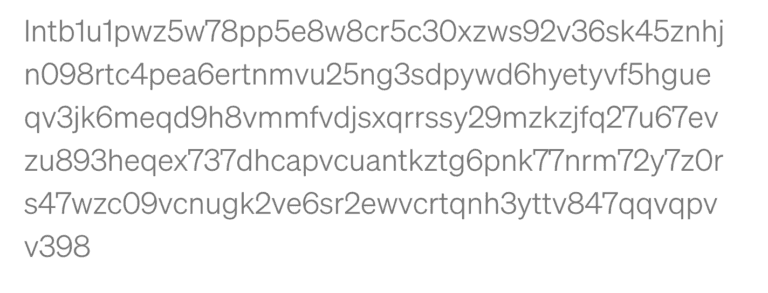
What Are Lightning Network Wallets?
A Lightning Network wallet allows users to make and receive payments via the Lightning Network, commonly referred to as Bitcoin’s Layer-2. It enables fast and cheap transactions on Bitcoin through the use of channels and Lightning nodes.

There are two types of wallets catering to different types of users.
Custodial Wallets
When you use a custodial wallet, your funds are parked with the custodian. As a result, you will need to trust that they won’t run away with your money or mismanage the business. On the other hand, you do not have the responsibility of safeguarding your own funds. When you want to send a payment, the wallet routes the funds on your behalf and shows you the balance you have with them. However, there’s no way for you to verify if the balance you see is true unless you move your funds to a non-custodial wallet through the Bitcoin network.
In return for your trust, custodial wallets take care of the node-running and channel management part for the user. All they need to do is follow the simple UI to send and receive funds. All the complicated stuff is handled by the wallet. In some cases, if two customers use the same app to send funds to each other, a channel is not needed as the wallet can shuffle the funds from one party to another using their system. You can also receive BTC via Lightning without having to first provide liquidity to activate the channel.
Non-Custodial Wallets
Security is solely on the user’s shoulders if they choose to go with a non-custodial wallet. Those who like to have complete control over their funds consider this a blessing as they do not have to trust a third party with their precious BTC.
Each non-custodial wallet has its own node. Some offer the option for users to connect to their node of choice instead of using the wallet’s node. Aside from that, other related operations such as channel management, including the opening and closing of channels, channel capacity etc can be handled by the non-custodial wallet for those who do not want to muck around. Certain wallets offer advanced users the ability to fiddle with channel-related settings.
One thing they will have to consider is how much BTC to allocate when opening a channel. This is because there needs to be a minimum amount of sats to keep the channel open, especially if it will be open for an extended period of time, like a running tab at a restaurant or your neighbourhood Quik-E Mart where you only settle the bill once a month.
If you are going to be using any non-custodial wallets for cryptocurrencies, I recommend checking out our article on crypto safety to ensure you are following the best practices to keep your crypto safe!
How Do Lightning Wallets Work?
It is a well-known fact that Bitcoin has a scaling problem. This makes it a less-than-ideal choice for a global payment system despite the super-tight security and value-retaining features. It wasn’t until the emergence of the Lightning Network, introduced by Thaddeus Dryjo and Joseph Poon in a white paper, that gave Bitcoin a shot at overcoming the issue of scalability.
The Lightning Network allows Bitcoin micropayments to happen off-chain through nodes and channels, similar to a sidechain for Ethereum. These micropayments are made instantly and save a lot on transaction costs, compared to the main Bitcoin network. Transactions that happen on the Lightning Network are not recorded on the main Bitcoin network except for the opening and closing of channels as these transactions carry the BTC balances needed to keep track of the overall balance. It’s like having a fixed amount for a monthly food budget but you may not track every single penny spent for food.
A Bitcoin Lightning wallet usually is its own Lightning node where it allows payments to be routed through it to other nodes/destinations. At the same time, it also enables channels to be opened and to be the party initiating the transaction to someone else.
The job of each Lightning node is to route payments. The compensation they get is the fees set by the node operators. In order to be a successful node operator, a certain amount of capital is required as liquidity. Insufficient liquidity from the nodes means that the payments will fail, and node operators won’t get any compensation.
To maintain the balance of funds in a node, you want to have almost equal amounts of inbound and outbound payments so that the funds in the node do not get depleted from making too many payments but not enough paid to you. Here is where fees come in.
There are two types of fees: the ones charged by the network and by the wallet. The amount of fees charged, denominated in sats, may not appear to be a lot in cash terms, but as the price of Bitcoin rises, there would be a significant difference between 120 sats and 12,000 sats. The fees charged include channel management and making a transaction or payment.
Aside from payments, the wallet also gives the users access to apps or locations where they can use their sats. This encourages more people to consider using Bitcoin for their daily needs.
The Top LN Wallets Reviewed & Ranked
In the following section, we will introduce a number of wallets, both custodial and non-custodial ones, for your consideration. Bearing in mind that the context is around ease of making payments in everyday situations, the focus is on mobile apps as most of us have accepted using some kind of e-wallet on our phones to pay for things.
Wallet of Satoshi
The official website of Wallet of Satoshi claims that it’s “the world’s simplest Bitcoin Lightning wallet” and it does appear so. This Lightning wallet is the custodial type that is only available on mobile for both Android and iOS users.
After downloading the app to your phone, you are greeted with a screen with the Send and Receive button, allowing you to instantly send or receive Bitcoin. For the full menu list, select the three lines in the top-right corner. Enter an email address to use the account on multiple devices.
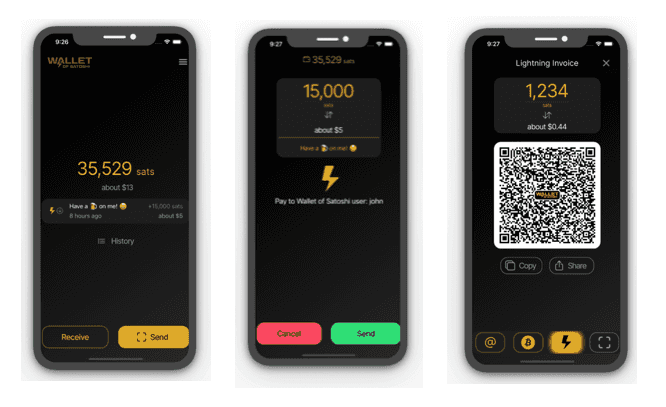
The wallet offers three ways to add funds to it: receiving Bitcoin from another wallet via the main Bitcoin network, Lightning Network, and buying Bitcoin directly from them. Moonpay is the partner for buying and selling Bitcoin through the app. Prior to entering your card details, you get an email notification with the verification code through the email address you entered for creating an account. Note that this is subject to the regions supported by Moonpay.
If you’re at a loss as to where you can spend your Bitcoin, the app links you up with btcmap.org which lets you know which vendors or ATMs in your area accept Bitcoin as payment. In terms of security, the app has a biometric setting and the ability to hide your balance.
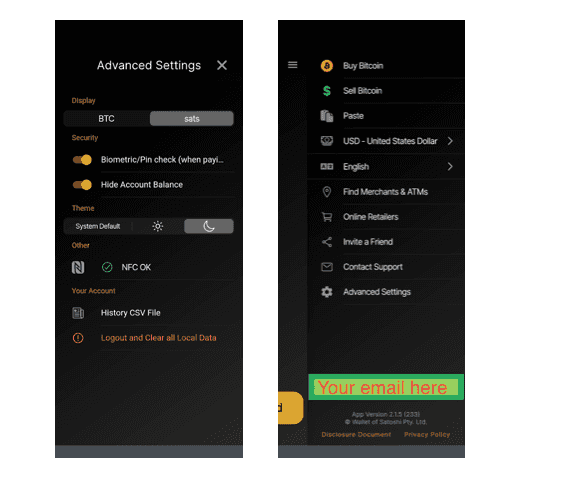
Overall, the clean and simple interface presents an inviting allure to use the app, giving users the confidence to try it out.
Electrum
Electrum is a non-custodial Bitcoin wallet designed specifically to store Bitcoin only. It’s been around since 2011 and is used by many of the Bitcoin OGs. Security is one of the great features of the wallet because it has a watching-only wallet function for tracking transactions, multisig abilities, and supports hardware wallets that were introduced by Guy in his Top 5 Hardware Wallets video. The wallet features both a desktop and mobile version (but only for Android), making it handy for mobile users to make payments to merchants.
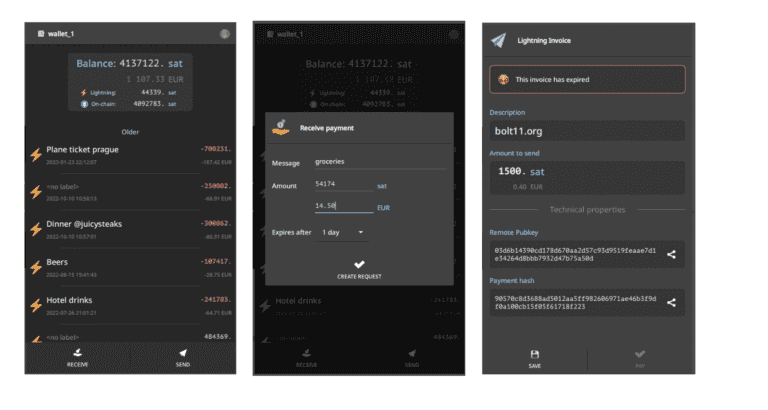
Electrum is also the oldest wallet to adopt Lightning network payments since they announced their support in 2020. The wallet itself is open-source and free to download. However, it is not a wallet for newbies as there are many options to configure the wallet to do a lot of things. However, it is great for those who want as complete control as possible over their wallet setup.
Breez Mobile
Breez Mobile is a non-custodial open-source wallet available in iOS and Android for Lightning payments. By using Breez, you are essentially running your own Lightning node on your mobile. You will also need to open a channel with Breez and have a minimum of around 600 sats in your balance to keep this wallet active.
To add funds to the wallet, you can make a BTC deposit from another address, buy Bitcoin, or use a FastBitcoins voucher. Note that both the actions of adding and removing funds involve interacting with the main Bitcoin network.

The wallet can be backed up to a cloud storage such as Google Drive so it’s not great for anonymity or if you want to divest yourself from the clutches of a big tech company. For extra protection, add a 12-word phrase during the backup process. That being said, it also lets you restore your wallet using your Google account. Note that the wallet is still in Beta mode so please use at your own risk.
What makes Breez interesting is that it’s not just a mobile wallet. It can also double as a Point-of-Sale app for merchants who want to accept Bitcoin for their products and services. In addition, you can also listen to podcasts on the app and support your favorite podcasters by paying them in sats. This is possible by giving them a “boost” with a one-time payment or entering an amount for Sats/minute, basically, pay as you listen.
Zap Wallet
Zap wallet is the brainchild of Jack Mallers, known for the Strike app, a payment network for merchants used by Shopify. He was one of the first to publicly preach the gospel of the Lightning Network to the masses. The non-custodial wallet, in both desktop (MacOS, Windows, Linux!) and mobile versions, is more suited for medium to advanced users. Some setup is required to get the wallet up and running. Jack has made some YouTube tutorials on this topic and a few more. Note that the mobile versions do not contain a Lightning node and require a separate node to use it.
You can connect the wallet to an existing node prior to opening a channel there. Future features include the ability to run a full Lightning node in one click and use the Tor network to connect, thus maximizing anonymity and security, plus the ability to buy Bitcoin directly from the app.
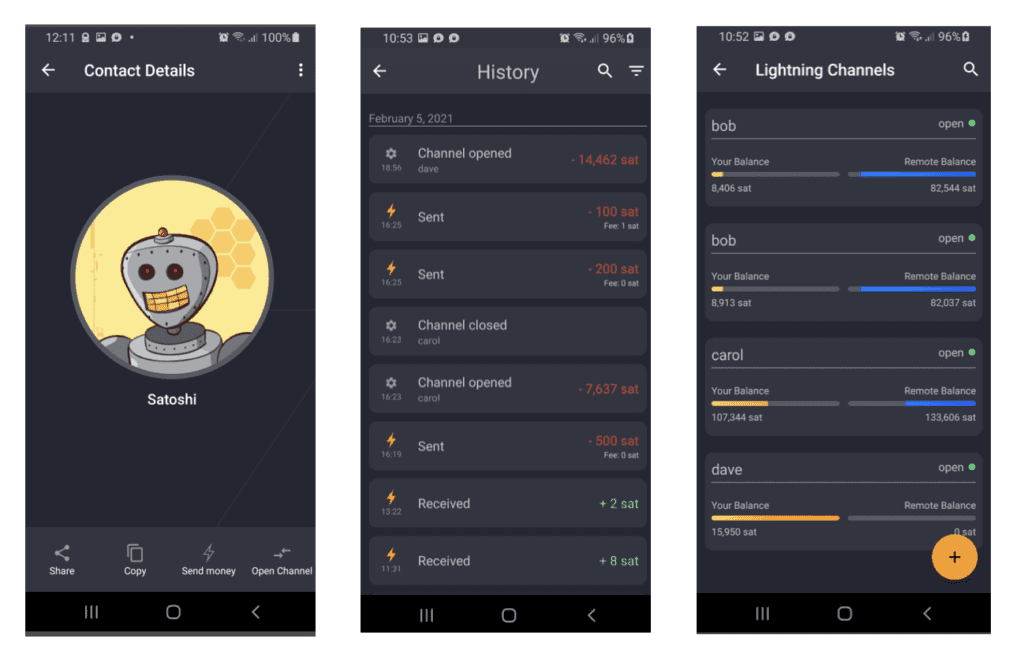
Muun Wallet
Launched in 2019, Muun Wallet is also a well-known option for a non-custodial Lightning Wallet, especially ever since Jack Dorsey tweeted about it in 2022. Security is a key concern with any wallet and Muun has taken great measures to keep your funds safe.
- 2 for 2 multisig, which means you hold one key for spending, and the other key is held by Muun.
- Emergency Kit that exports your private keys and output descriptors. Both pieces of information combined tells you how to find your funds on the Bitcoin network.
- Choose between a randomly-generated code or multi-factor authentication as your backup option.

Muun Wallet also has some interesting features not found in other wallets. These include:
- Lightning Invoices expiration from 1 hour to 24 hours
- Mempool estimator is a tool to check that you are neither overpaying nor underestimating fees required for the transaction.
- Submarine Swap is a feature that involves making payments via a third party known as a swap provider. In situations where you need to pay someone but you don’t have a direct channel with that person, the funds will then go through a swap provider who helps you pass along the funds to the intended party. The swap provider sends the funds to the recipient first, then claims the same amount from the sender by the revelation of a secret created by the recipient within a certain timeframe.
Phoenix wallet
ACINQ, one of the teams that contribute to the development of the Lightning network and created the Eclair wallet, has released another product called Phoenix Wallet while sunsetting the former one.
Phoenix is a non-custodial mobile native LN wallet for both iOS and Android users. It will handle the opening and closing of channels for you and the wallet itself is a full-fledged Lightning node. A minimum of 10,000 sats is needed to open the channel and “activate” the account.
The wallet allows for on-the-fly channel creation but there’s a fee involved. This function is recommended to be disabled on the app as it may result in the unnecessary creation of multiple channels when receiving payment amounts that exceed the channel’s balance limit. When this function is disabled, unsuccessful payments will simply fail, thus never leaving the sender’s wallet.

Zeus Wallet
Rather than a straight-up wallet, the Zeus Wallet app is more of a mobile version of a Lightning node management app that allows for Lightning payments to be made on it. This app does not have its own node and requires the user to connect to an existing node. This alone makes it out of reach for beginners. However, for those who are interested to run their own node, this would be a good app to consider.
The app is open-sourced and non-custodial, and supports both Lightning and the Bitcoin network itself, with a strong privacy focus through Tor connection and the ability to hide the sending data in Privacy mode.

Bitcoin Beach Wallet (Blink)
The Bitcoin Beach Wallet was created at El Zonte in El Salvador, the only country in the world that currently accepts Bitcoin as legal tender. The wallet is helping enable El Salvadorians with the ability to make quick and cheap transfers of Bitcoin, dating back to 2020. Unlike Chivo, the official wallet used only by El Salvadoreans, the Bitcoin Beach wallet is available for anyone around the world.
The app is designed not only for beginners using the Lightning Network but also for onboarding newbies to Bitcoin. It features an Earn and Learn section where users can stack sats by learning about Bitcoin. Other features include:
- Multi-language support
- Multi-currency support
- Stablesats – an open-source project that creates a form of “synthetic USD” through a derivatives trading strategy in the background. The result is that users can receive, send, and hold their funds in a USD equivalent account.
- Localised map showing where one can spend their sats.
- Log in using your phone number.
- Integration with Nostr for tipping

The app also has a merchant interface that acts as a Point-of-Sale (POS) system for accepting Bitcoin payments.
Lightning Network Development and Adoption Rate
Although the idea of having a payment channel has been around for as long as Bitcoin, it wasn’t until the Lightning Network white paper, released in February 2015 by Joseph Poon and Thaddeus Dryja, that the idea really caught on. Central to the white paper is the Hashed Timelock Contract (HTLC), used for payment routing over multiple channels, that gave Lightning Network a meaty feature.
In August 2015, ACINQ debuted its new implementation of the Lightning Network known as Eclair. Not long after, they unveiled the Android version of their Lightning wallet by the same name. This was quickly followed by Lightning Labs and Blockstream. The three companies were the main actors pushing the development of the Lightning protocol.
From the first purchase of a physical item in January 2018 to today, where there are companies like Bitrefill and Fold App to name a few that offer BTC purchases for daily necessities, adoption is slow but surely growing by the day. As more and more people cotton on to the possibility of using Bitcoin to make payments, the promise of a future where Bitcoin can be accepted alongside cash is coming ever closer.
Closing Thoughts On LN Wallets
A key impetus for me to do this article is because I was recently introduced to Bitrefill and the possibilities of paying for daily necessities using Bitcoin. I then decided to go on the hunt for a good Lightning wallet to use and share my findings with you. It’s clear to me that mobile apps are the way to go for maximum convenience.
Depending on how adventurous I am (or you are), I may consider running my own Lightning node in the future. For now though, I’m happy to use a custodial wallet as the quickest and easiest way to dip my toes in. While there is a risk of funds’ safety with a custodial wallet, it’s worth pausing a moment to consider: if I only keep 10,000 sats in that wallet, and it’s all gone, that’s a small price to pay, whereas I may benefit greatly from the upside.
Once you start seeing Bitcoin as a denomination of sorts, it could be a gradual shift to viewing the value of items in sats instead of dollars. Somewhere in there is the germination of a way of seeing the world in a completely different manner.
Disclaimer: These are the writer’s opinions and should not be considered investment advice. Readers should do their own research.
Frequently Asked Questions
Electrum is a known Bitcoin wallet that also has the option for using Lightning. Exodus is a wallet that supports both Bitcoin and Lightning.
No, the Coinbase wallet does not support the Lightning Network. Recently though, Coinbase announced that they will be supporting the Lightning network. When that happens, they might extend that support to their wallet.
Not quite. a Bitcoin wallet stores Bitcoin and all transactions are performed on the main Bitcoin network. A Lightning wallet utilises channels between two parties for transactions. These are known as off-chain transactions that Bitcoin knows nothing about. Only the opening and closing channels are recorded on the Bitcoin network.
Even though some of the wallets might be in Beta version, the wallets in general have no glaring security risk. Please bear in mind that the Lightning Network is still being developed as we speak, so we recommend only putting in an amount you won’t lose sleep over at any time.
Both Wallet of Satoshi and Blink are some of the simplest Lightning wallets currently in the market.
Lightning Wallets can be easily downloaded via the App Store or Google’s Playstore as long as the wallet supports iOS and/or Android. The wallets are free to download.
An LN wallet is a wallet that supports the using the Lightning Network for making cheap and near-instant payments over the Bitcoin network.
Depending on what kind of crypto you hold, popular ones include Metamask, Exodus, and Coinbase Wallet to name a few. For more information about them and many more, we suggest taking a look at our Top Wallets Guide for a more comprehensive introduction.
A cold wallet, known as hardware wallet, are hands-down, the best wallets for storing cryptocurrency. We’ve got a great selection for you to choose from in the Most secure wallet article.
Disclaimer: These are the writer’s opinions and should not be considered investment advice. Readers should do their own research.


